Human–Wildlife Interaction—A Social Survey
Abstract
Simple Summary
Abstract
1. Introduction
2. Materials and Methods
2.1. The Study Setup
2.2. Data Preparation and Evaluation
- Emotion score (EmS): This included two questions asking the participants about their feelings towards species and about negative emotions like fear or disgust regarding wildlife.
- Engagement score (EnS): This consisted of three questions related to the participants’ past and future commitment to wildlife such as financial, active or political involvement or how much financial support would be granted for the care of a wild animal in need.
- Experience score (ExS): This included three questions about the types of interactions with wildlife that had been experienced, whether any wildlife had ever been found in distress, and, if so, what action had been taken.
- Knowledge score (KS): This consisted of four questions from the “quiz” section, containing questions about the responsibilities, legal framework regarding wildlife, and zoonotic diseases.
- Opinion score (OS): This included two questions asking for agreement or disagreement with various exemplary ways of dealing with wildlife, e.g., handling referred to reintroduction, euthanasia for animal welfare reasons, and the keeping of wild animals.
2.3. Statistical Analysis
3. Results
3.1. Participants
3.2. Emotion
3.3. Engagement
3.4. Experience
3.5. Knowledge
3.6. Opinion
3.7. Volunteer Questionnaire
3.8. Statistical Score Evaluation
4. Discussion
5. Conclusions
Supplementary Materials
Author Contributions
Funding
Institutional Review Board Statement
Informed Consent Statement
Data Availability Statement
Acknowledgments
Conflicts of Interest
Appendix A
| Score | Question | Answer Options |
|---|---|---|
| Emotion score (EmS) | Rate the following animal species according to your feelings toward them (1–5). |
|
| To what extent do the following feelings about some wildlife apply to you? Please rate (1–5). |
| |
| Engagement score (EnS) | Have you ever been privately involved in native species conservation programs? |
|
| To what extent would you be willing to get involved with native wildlife in the future? |
| |
| How much money would you be willing to pay to a veterinary practice/wildlife center for the care of a wild animal you have rescued? |
| |
| Experience score (ExS) | What kind of encounters have you had with wildlife so far? |
|
| Have you ever found a wild animal in need of help? |
| |
| You stated that you have found a wild animal in need of help once or several times. Please indicate how you reacted for all applicable animal groups. (taken care of by myself/handed over to a specialist/left in the wild) |
| |
| Knowledge score (KS) | Who is legally responsible for an injured wild animal that is not subject to hunting laws? |
|
| When is it legal to take a wild animal from the wild? |
| |
| Are veterinarians obliged to treat wild animals free of charge? |
| |
| Which of the following diseases belong to zoonoses? (Zoonoses = diseases that can be transmitted between animals and humans) |
| |
| Opinion score (OS) | To what extent do you agree with the following statements? (1–5) |
|
| If necessary, do you consider the following measures to be justified for protection from wildlife damage in urban areas? (yes/unsure/no) |
|
| Df | Deviance Resid. | Resid. Df | Resid. Dev | p | Significance 1 | ||
|---|---|---|---|---|---|---|---|
| NULL | 1272 | 23,012 | |||||
| Personal factors | |||||||
| GE | 3 | 1663.40 | 1269 | 21,349 | <0.0001 | *** | |
| A | 1 | 2.56 | 1268 | 21,346 | 0.6439 | ||
| R | 6 | 54.92 | 1215 | 14,706 | 0.5969 | ||
| PE | 9 | 1571.50 | 1259 | 19,775 | <0.0001 | *** | |
| VE | 2 | 91.11 | 1257 | 19,683 | 0.0224 | * | |
| HE | 4 | 2002.87 | 1253 | 17,681 | <0.0001 | *** | |
| Risk awareness | |||||||
| RH | 4 | 91.23 | 1249 | 17,589 | 0.1068 | ||
| RD | 4 | 1184.26 | 1245 | 16,405 | <0.0001 | *** | |
| RI | 4 | 139.18 | 1241 | 16,266 | 0.0206 | * | |
| RF | 4 | 328.20 | 1237 | 15,938 | 0.0183 | *** | |
| RE | 4 | 245.31 | 1233 | 15,692 | 0.0004 | *** | |
| RL | 4 | 212.95 | 1229 | 15,479 | 0.0014 | *** | |
| RNP | 4 | 29.00 | 1225 | 15,450 | 0.6579 | ||
| Scores | |||||||
| KS | 1 | 399.08 | 1224 | 15,051 | <0.0001 | *** | |
| EmS | 1 | 216.95 | 1223 | 14,834 | 0.0220 | *** | |
| ExS | 1 | 68.96 | 1222 | 14,766 | 0.1646 | * | |
| EnS | 1 | 4.26 | 1221 | 14,761 | 0.5505 | ||
| Interactions | |||||||
| VE:EmS | 2 | 17.95 | 1213 | 14,688 | 0.4721 | ||
| HE:EmS | 4 | 237.78 | 1209 | 14,450 | 0.0006 | *** | |
| Df | Deviance Resid. | Df, K | Resid. Dev. | p | Significance 1 | ||
|---|---|---|---|---|---|---|---|
| NULL | 1286 | 61,699 | |||||
| Personal factors | |||||||
| GE | 3 | 2951.5 | 1282 | 50,081 | <0.0001 | *** | |
| A | 1 | 10.1 | 1281 | 50,071 | 0.5868 | ||
| PE | 9 | 1394.5 | 1272 | 48,676 | 0.0070 | *** | |
| VE | 2 | 104.3 | 1270 | 48,572 | 0.2183 | ||
| HE | 4 | 3340.3 | 1266 | 45,231 | <0.0001 | *** | |
| R | 6 | 633.8 | 1260 | 44,598 | 0.0053 | ** | |
| Scores | |||||||
| KS | 1 | 5.7 | 1259 | 44,592 | 0.6845 | ||
| EnS | 1 | 1538.3 | 1258 | 43,054 | <0.0001 | *** | |
| ExS | 1 | 8666.8 | 1285 | 53,032 | <0.0001 | *** | |
References
- The IUCN Red List of Threatened Species. Version 2022-2. Available online: https://www.iucnredlist.org (accessed on 1 October 2023).
- Czech, B.; Krausman, P.R.; Devers, P.K. Economic Associations among Causes of Species Endangerment in the United States. BioScience 2000, 50, 593–601. [Google Scholar] [CrossRef]
- McKinney, M.L. Urbanization, Biodiversity, and Conservation. BioScience 2002, 52, 883–890. [Google Scholar] [CrossRef]
- Luena, C. Report on the EU Biodiversity Strategy for 2030: Bringing Nature Back into Our Lives (2020/2273(INI)). European Parliament. 2021. Available online: https://www.europarl.europa.eu/doceo/document/TA-9-2021-0277_EN.html (accessed on 10 October 2023).
- Gans, P. Urban Population Development in Germany (2000–2014):The Contribution of Migration by Age and Citizenship to Reurbanisation. Comp. Popul. Stud. 2018, 42, 319–352. [Google Scholar] [CrossRef]
- Ritchie, H.; Roser, M. Urbanization. Our World in Data. 2018. Available online: https://ourworldindata.org/ (accessed on 22 November 2023).
- Tikhonova, G.N.; Tikhonov, I.A.; Bogomolov, P.L. Impact of a small city on the structure of small mammal fauna in forests of the northeastern Moscow region. Russ. J. Ecol. 2006, 37, 278–283. [Google Scholar] [CrossRef]
- Zorenko, T.; Leontyeva, T. Species Diversity and Distribution of Mammals in Riga. Acta Zool. Litu. 2012, 13, 78–86. [Google Scholar] [CrossRef]
- Grimm, N.B.; Faeth, S.H.; Golubiewski, N.E.; Redman, C.L.; Wu, J.; Ba, X.; Briggs, J.M. Global Change and the Ecology of Cities. Science 2008, 319, 756–760. [Google Scholar] [CrossRef] [PubMed]
- Murray, M.H.; Sánchez, C.A.; Becker, D.J.; Byers, K.A.; Worsley-Tonks, K.E.L.; Craft, M.E. City sicker? A meta-analysis of wildlife health and urbanization. Front. Ecol. Environ. 2019, 17, 575–583. [Google Scholar] [CrossRef]
- Klem, D.; Farmer, C.J.; Delacretaz, N.; Gelb, Y.; Saenger, P.G. Architectural and Landscape Risk Factors Associated with Bird–glass Collisions in an Urban Environment. Wilson J. Ornithol. 2009, 121, 126–134. [Google Scholar] [CrossRef]
- Wegworth, C.; Vogelschutz und Glasarchitektur im Stadtraum Berlin. Eine Aktuelle Bestandsaufnahme und Ermittlung von Erfordernissen für Eine Verantwortungsvolle Stadtplanung. 2019. Available online: https://nbn-resolving.de/urn:nbn:de:kobv:109-1-15455762 (accessed on 21 November 2023).
- Timm, M.; Kime, N. Effects of Cat and Dog interactions on Urban Wildlife Admitted to a Wildlife Center in Wisconsin. J. Young Investig. 2020, 38, 61–66. [Google Scholar] [CrossRef]
- Trouwborst, A.; Somsen, H. Domestic cats (Felis catus) and European nature conservation law—Applying the EU Birds and Habitats Directives to a significant but neglected threat to wildlife. J. Environ. Law 2020, 32, 391–415. [Google Scholar] [CrossRef]
- Elzanowski, A.; Ciesiołkiewicz, J.; Kaczor, M.; Radwańska, J.; Urban, R. Amphibian road mortality in Europe: A meta-analysis with new data from Poland. Eur. J. Wildl. Res. 2008, 55, 33–43. [Google Scholar] [CrossRef]
- Herrmann, M.; Mathews, A. Wirkung von Barrieren auf Säuger & Reptilien; Report; 2007. Available online: https://www.google.com/url?sa=t&rct=j&q=&esrc=s&source=web&cd=&cad=rja&uact=8&ved=2ahUKEwjipvGmxc2EAxVdSvEDHRkfAa0QFnoECA8QAQ&url=https%3A%2F%2Fwww.jagdverband.de%2Fsites%2Fdefault%2Ffiles%2Fherrmann_endberichtdok20_0.pdf&usg=AOvVaw3H_Nsg4vmQYOJp__cBUumJ&opi=89978449 (accessed on 20 March 2023).
- Schwartz, A.L.W.; Shilling, F.M.; Perkins, S.E. The value of monitoring wildlife roadkill. Eur. J. Wildl. Res. 2020, 66, 18. [Google Scholar] [CrossRef]
- Rico, A.; Kindlmann, P.; Sedláček, F. Barrier effects of roads on movements of small mammals. Folia Zool. 2007, 56, 1–12. [Google Scholar]
- Keller, L.F.; Waller, D.M. Inbreeding effects in wild populations. Trends Ecol. Evol. 2002, 17, 230–241. [Google Scholar] [CrossRef]
- Wandeler, P.; Funk, S.M.; Largiadèr, C.R.; Gloor, S.; Breitenmoser, U. The city-fox phenomenon: Genetic consequences of a recent colonization of urban habitat. Mol. Ecol. 2003, 12, 647–656. [Google Scholar] [CrossRef] [PubMed]
- Angold, P.G.; Sadler, J.P.; Hill, M.O.; Pullin, A.; Rushton, S.; Austin, K.; Small, E.; Wood, B.; Wadsworth, R.; Sanderson, R.; et al. Biodiversity in urban habitat patches. Sci. Total Environ. 2006, 360, 196–204. [Google Scholar] [CrossRef] [PubMed]
- Gloor, S. The Rise of Urban Foxes (Vulpes vulpes) in Switzerland and Ecological and Parasitological Aspects of a Fox Population in the Recently Colonised City of Zurich. Ph.D. Thesis, Universität Zürich, Zürich, Switzerland, 2002. [Google Scholar]
- Donaldson, M.R.; Henein, K.M.; Runtz, M.W. Assessing the effect of developed habitat on waterbird behaviour in an urban riparian system in Ottawa, Canada. Urban Ecosyst. 2007, 10, 139–151. [Google Scholar] [CrossRef]
- Evans, J.; Boudreau, K.; Hyman, J. Behavioural Syndromes in Urban and Rural Populations of Song Sparrows. Ethology 2010, 116, 588–595. [Google Scholar] [CrossRef]
- Lowry, H.; Lill, A.; Wong, B.B. Behavioural responses of wildlife to urban environments. Biol. Rev. Camb. Philos. Soc. 2013, 88, 537–549. [Google Scholar] [CrossRef]
- Gil-Fernández, M.; Harcourt, R.; Newsome, T.; Towerton, A.; Carthey, A. Adaptations of the red fox (Vulpes vulpes) to urban environments in Sydney, Australia. J. Urban Ecol. 2020, 6, juaa009. [Google Scholar] [CrossRef]
- Hubert, P.; Julliard, R.; Biagianti, S.; Poulle, M.-L. Ecological factors driving the higher hedgehog (Erinaceus europeaus) density in an urban area compared to the adjacent rural area. Landsc. Urban Plan. 2011, 103, 34–43. [Google Scholar] [CrossRef]
- Drahníková, L.; Tkadlec, E. Changes in home range sizes and population densities of carnivore species along the natural to urban habitat gradient. Mammal Rev. 2014, 45, 1–14. [Google Scholar] [CrossRef]
- Nyhus, P.J. Human–Wildlife Conflict and Coexistence. Annu. Rev. Environ. Resour. 2016, 41, 143–171. [Google Scholar] [CrossRef]
- Peerenboom, G.; Betge, F.; Janko, C.; Storch, I. Wildtiermanagement im Siedlungsraum-Ein Handbuch für Kreise und Kommunen in Baden-Württemberg; Professur für Wildtierökologie und Wildtiermanagement; Albert-Ludwigs-Universität Freiburg im Breisgau: Freiburg im Breisgau, Germany, 2020. [Google Scholar]
- Wimberger, K.; Downs, C. Annual intake trends of a large urban animal rehabilitation centre in South Africa: A case study. Anim. Welf. 2010, 19, 501–513. [Google Scholar] [CrossRef]
- Gage, L.J.; Duerr, R.S. Hand-Rearing Birds; ebook; Blackwell Publishing: Hoboken, NJ, USA, 2008. [Google Scholar]
- Tierschutzgesetz in der Fassung der Bekanntmachung vom 18. Mai 2006 (BGBl. I S. 1206, 1313), das zuletzt durch Artikel 2 Absatz 20 des Gesetzes vom 20. Dezember 2022 (BGBl. I S. 2752) geändert worden ist. 2006.
- Bundesnaturschutzgesetz vom 29. Juli 2009 (BGBl. I S. 2542), das zuletzt durch Artikel 3 des Gesetzes vom 8. Dezember 2022 (BGBl. I S. 2240) geändert worden ist. 2009.
- Johansson, M.; Dressel, S.; Kvastegård, E.; Ericsson, G.; Fischer, A.; Kaltenborn, B.P.; Vaske, J.J.; Sandström, C. Describing human–wildlife interaction from a European perspective. Hum. Dimens. Wildl. 2016, 21, 158–168. [Google Scholar] [CrossRef]
- Gethöffer, F.; Kirberg, S.; Schöttes, F.; Siebert, U. Der Umgang mit Neozoen—Ein gesellschaftlicher Diskurs. Naturschutz Landschaftsplan. 2022, 54, 30–36. [Google Scholar] [CrossRef]
- Sogliani, D.; Cerri, J.; Turetta, R.; Crema, M.; Corsini, M.; Mori, E. Feral rabbit populations in a peri-urban area: Insights about invasion dynamics and potential management strategies. Eur. J. Wildl. Res. 2021, 67, 60. [Google Scholar] [CrossRef]
- Cerri, J.; Mori, E.; Vivarelli, M.; Zaccaroni, M. Are wildlife value orientations useful tools to explain tolerance and illegal killing of wildlife by farmers in response to crop damage? Eur. J. Wildl. Res. 2017, 63, 70. [Google Scholar] [CrossRef]
- Giunchi, D.; Mucci, N.; Bigi, D.; Mengoni, C.; Baldaccini, N.E. Feral pigeon populations: Their gene pool and links with local domestic breeds. Zoology 2020, 142, 125817. [Google Scholar] [CrossRef]
- Arleth, C.; Hübel, J. Rechtsgutachten Stadttaubenschutz. 2021. Available online: https://www.berlin.de/lb/tierschutz/tauben/artikel.1163064.php (accessed on 21 November 2023).
- Likert, R. A technique for the measurement of attitudes. Arch. Psychol. 1932, 22, 5–55. [Google Scholar]
- Bauer, F. Einstellungen der Verschiedenen Interessensgruppen in Kärnten Gegenüber Europäischen Braunbären (Ursus arctos arctos). Master’s Thesis, Universität für Bodenkultur Wien, Wien, Austria, 2020. [Google Scholar]
- Schecker, H. Überprüfung der Konsistenz von Itemgruppen mit Cronbachs α. In Methoden in der Naturwissenschaftsdidaktischen Forschung; Krüger, D., Parchmann, I., Schecker, H., Eds.; Springer: Berlin/Heidelberg, Germany, 2014. [Google Scholar]
- Schmitt, N. Uses and abuses of coefficient alpha. Psychol. Assess. 1996, 8, 350–353. [Google Scholar] [CrossRef]
- Akaike, H. Maximum likelihood identification of Gaussian autoregressive moving average models. Biometrika 1973, 60, 255–265. [Google Scholar] [CrossRef]
- Cook, R.D.; Weisberg, S. Residuals and Influence in Regression; Chapman and Hall: New York, NY, USA, 1982. [Google Scholar]
- R Core Team. R: A Language and Environment for Statistical Computing; R Core Team: Vienna, Austria, 2023; Available online: https://posit.co/products/open-source/rstudio/ (accessed on 6 January 2023).
- Rani, S.R.M. Questionnaire Designing for a Survey. J. Indian Orthod. Soc. 2012, 46, 273–277. [Google Scholar]
- Miao, Z.; Wang, Q.; Lu, X.; Chen, D.; Zhang, W.; Zhou, X.; MacMillan, D.C. Compassionate Conservation and the Challenge of Sustainable Wildlife Management: A Survey of the Urban Public of China. Animals 2021, 11, 2521. [Google Scholar] [CrossRef] [PubMed]
- Davey, G.C.L. Characteristics of individuals with fear of spiders. Anxiety Res. 1991, 4, 299–314. [Google Scholar] [CrossRef]
- Schlegel, J.; Rupf, R. Attitudes towards potential animal flagship species in nature conservation: A survey among students of different educational institutions. J. Nat. Conserv. 2010, 18, 278–290. [Google Scholar] [CrossRef]
- Kendler, K.S.; Neale, M.C.; Kessler, R.C.; Heath, A.C.; Eaves, L.J. The genetic epidemiology of phobias in women. The interrelationship of agoraphobia, social phobia, situational phobia, and simple phobia. Arch. Gen. Psychiatry 1992, 49, 273–281. [Google Scholar] [CrossRef] [PubMed]
- Kellert, S.R. Values and Perceptions of Invertebrates. Conserv. Biol. 1993, 7, 845–855. [Google Scholar] [CrossRef]
- Davey, G.C.L. The “Disgusting” Spider: The Role of Disease and Illness in the Perpetuation of Fear of Spiders. Soc. Anim. 1994, 2, 17–25. [Google Scholar] [CrossRef]
- Dobeic, M.; Pintarič, Š.; Vlahović, K.; Dovč, A. Feral pigeon (Columba livia) population management in Ljubljana. Vet. Arhiv. 2011, 81, 285–298. [Google Scholar]
- Kellert, S.R. Attitudes, Knowledge, and Behavior Toward Wildlife Among the Industrial Superpowers: United States, Japan, and Germany. J. Soc. Issues 1993, 49, 53–69. [Google Scholar] [CrossRef]
- Lindemann-Matthies, P. ‘Loveable’ mammals and ‘lifeless’ plants: How children’s interest in common local organisms can be enhanced through observation of nature. Int. J. Sci. Educ. 2005, 27, 655–677. [Google Scholar] [CrossRef]
- Ehrhart, S. 8 Denzlinger Wildtierforum—Umfrageergebnisse; Denzlinger Wildtierforum; Forstliche Versuchs- und Forschungsanstalt Baden-Württemberg: Breisgau, Germany, 2021. [Google Scholar]
- Mole, R.; Schell, C.; Erdmann, K.-H.; Schuster, B.; Mues, A.W. Naturbewusstsein 2021 Bevölkerungsumfrage zu Natur und Biologischer Vielfalt; Bundesamt für Naturschutz: Bonn, Germany, 2023; p. 139. [Google Scholar]
- Manfredo, M.J.; Teel, T.L.; Henry, K.L. Linking Society and Environment A Multilevel Model of Shifting Wildlife Value. Soc. Sci. Q. 2009, 90, 407–427. [Google Scholar] [CrossRef]
- Vail, R.M. The Back Page Wildlife as pets: Reshaping public perceptions through targeted communication. Hum.-Wildl. Interact. 2018, 12, 293–298. [Google Scholar]
- Hart, P.S.; Larson, B.M.H. Communicating About Invasive Species: How “Driver” and “Passenger” Models Influence Public Willingness to Take Action. Conserv. Lett. 2014, 7, 545–552. [Google Scholar] [CrossRef]
- Singer, P. Animal Liberation; Random House UK Ltd.: New York, NY, USA, 1975; p. 330. [Google Scholar]
- Sillero-Zubiri, C.; Sukumar, R.; Treves, A. Living with wildlife: The roots of conflict and the solutions. In Key Topics in Conservation Biology; Blackwell Publishing: Hoboken, NJ, USA, 2007; pp. 266–272. [Google Scholar]
- Rink, D. Wilderness: The Nature of Urban Shrinkage? The Debate on Urban Restructuring and Restoration in Eastern Germany. Nat. Cult. 2009, 4, 275–292. [Google Scholar] [CrossRef]
- Weisser, W.W.; Hauck, T.E. Animal-Aided Design—Using a species’ life-cycle to improve open space planning and conservation in cities and elsewhere. bioRxiv 2017. [Google Scholar] [CrossRef]
- Grundei, L.; Schöttes, F.; Gethöffer, F.; Brethorst, S.V.; Siebert, U.; Pees, M. Handlungsempfehlungen zum Umgang mit heimischen Wildtieren. 2023. Available online: https://www.tiho-hannover.de/itaw/wildtierdiskurs (accessed on 21 November 2023).
- JWMG. Jagd- und Wildtiermanagementgesetz (JWMG) vom 25. November 2014, letzte berücksichtigte Änderung: §§ 13a und 5. 2014.
- Weber, T.; Nelke, A.; Kunzmann, P. Zukunftsdiskurse—Wie Menschen über Tiere Streiten; Stiftung Tierärztliche Hochschule Hannover, Institut für Tierhygiene, Tierschutz und Nutztierethologie: Hannover, Germany, 2012. [Google Scholar]
- Johansson, M.; Karlsson, J.; Pedersen, E.; Flykt, A. Factors Governing Human Fear of Brown Bear and Wolf. Hum. Dimens. Wildl. 2012, 17, 58–74. [Google Scholar] [CrossRef]
- Collins, M.K.; Magle, S.B.; Gallo, T. Global trends in urban wildlife ecology and conservation. Biol. Conserv. 2021, 261, 109236. [Google Scholar] [CrossRef]
- Magle, S.B.; Hunt, V.M.; Vernon, M.; Crooks, K.R. Urban wildlife research: Past, present, and future. Biol. Conserv. 2012, 155, 23–32. [Google Scholar] [CrossRef]

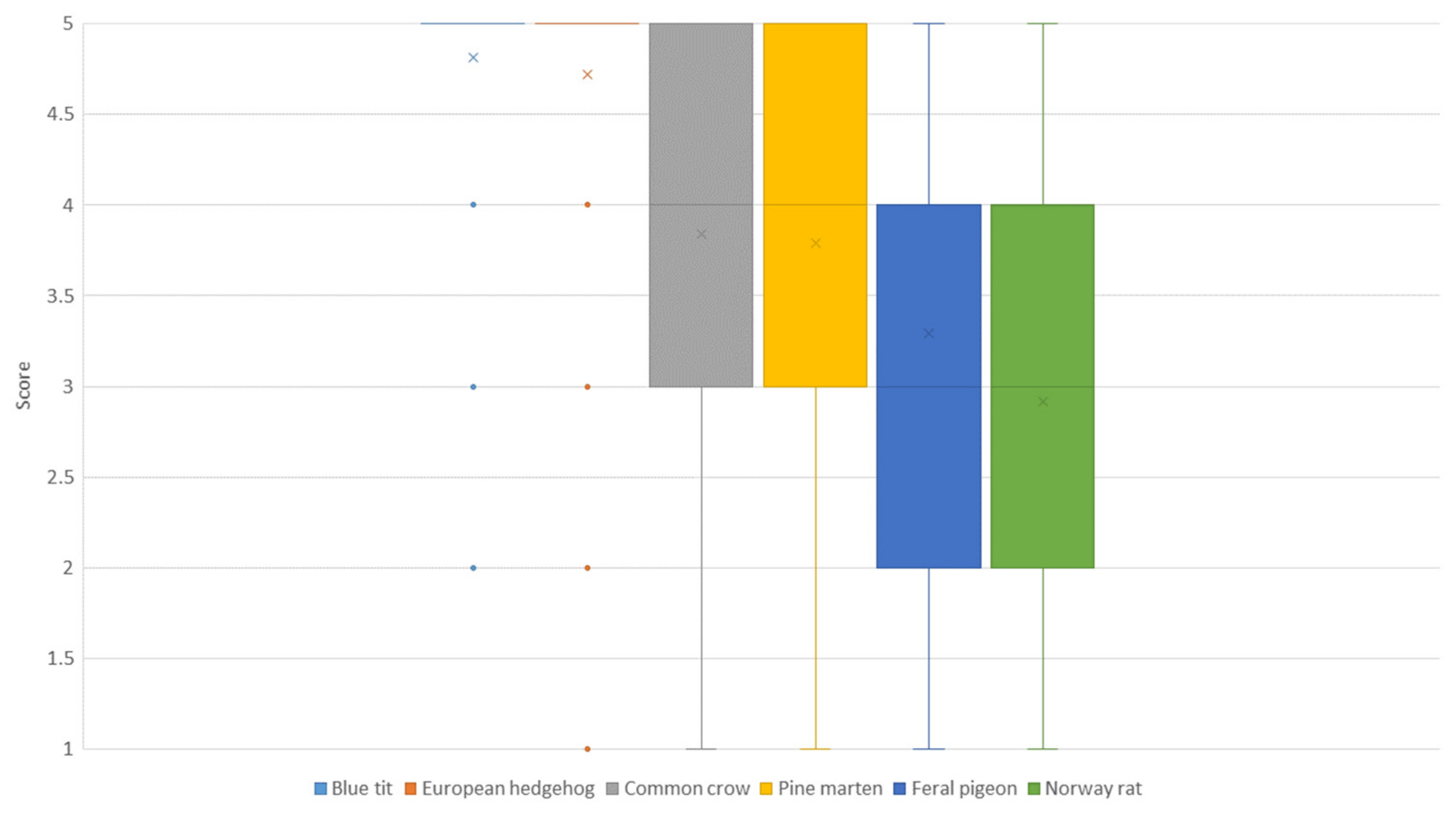
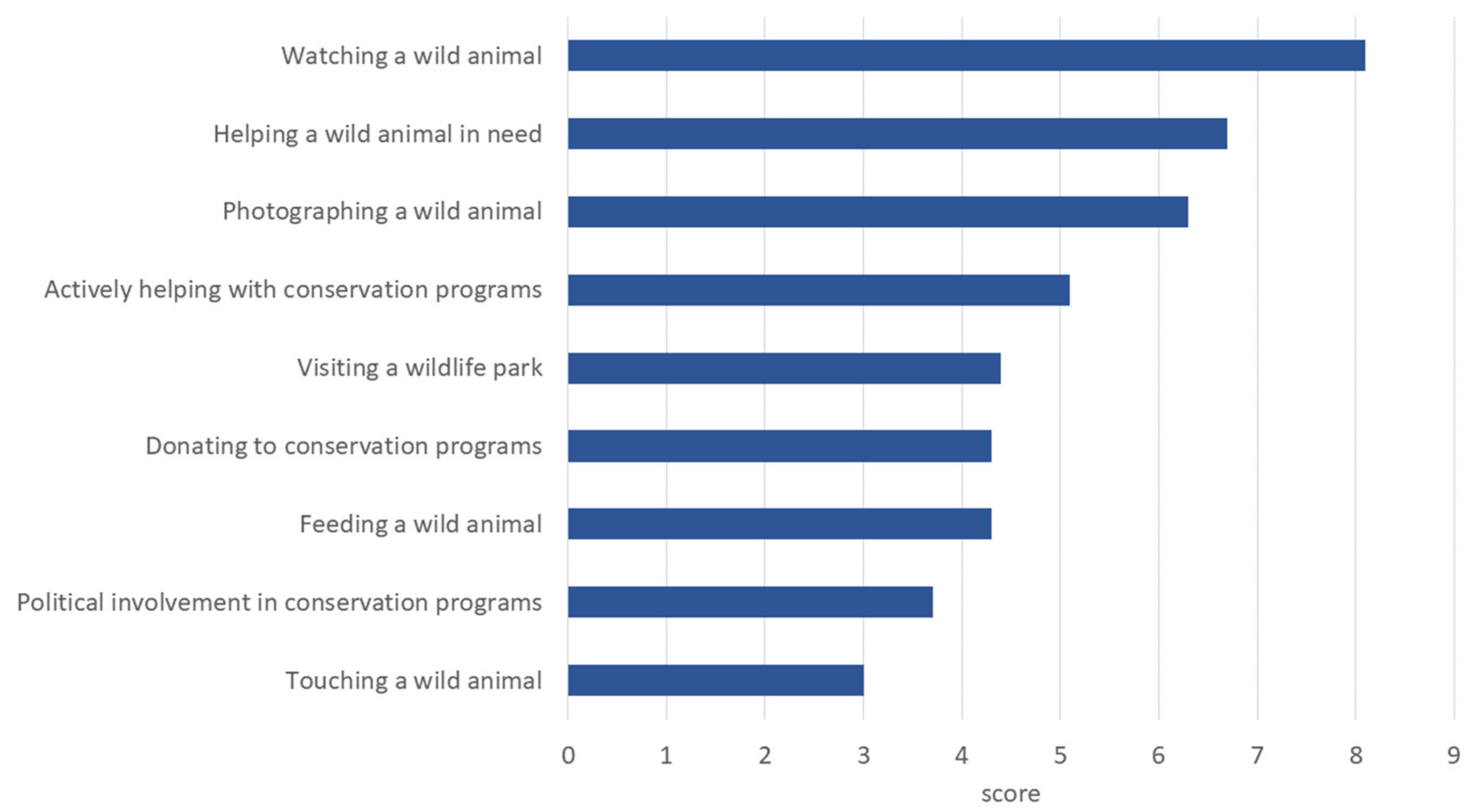



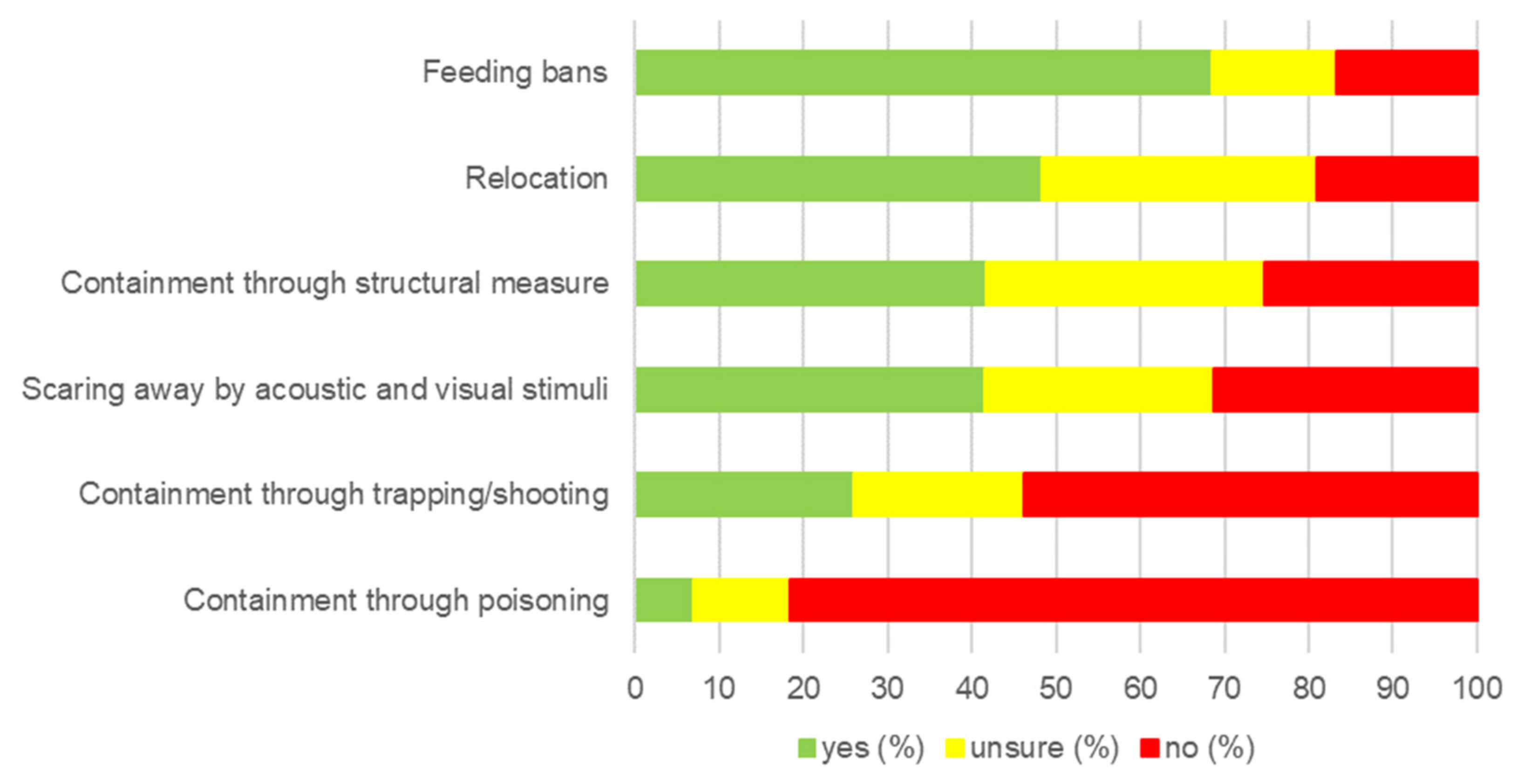



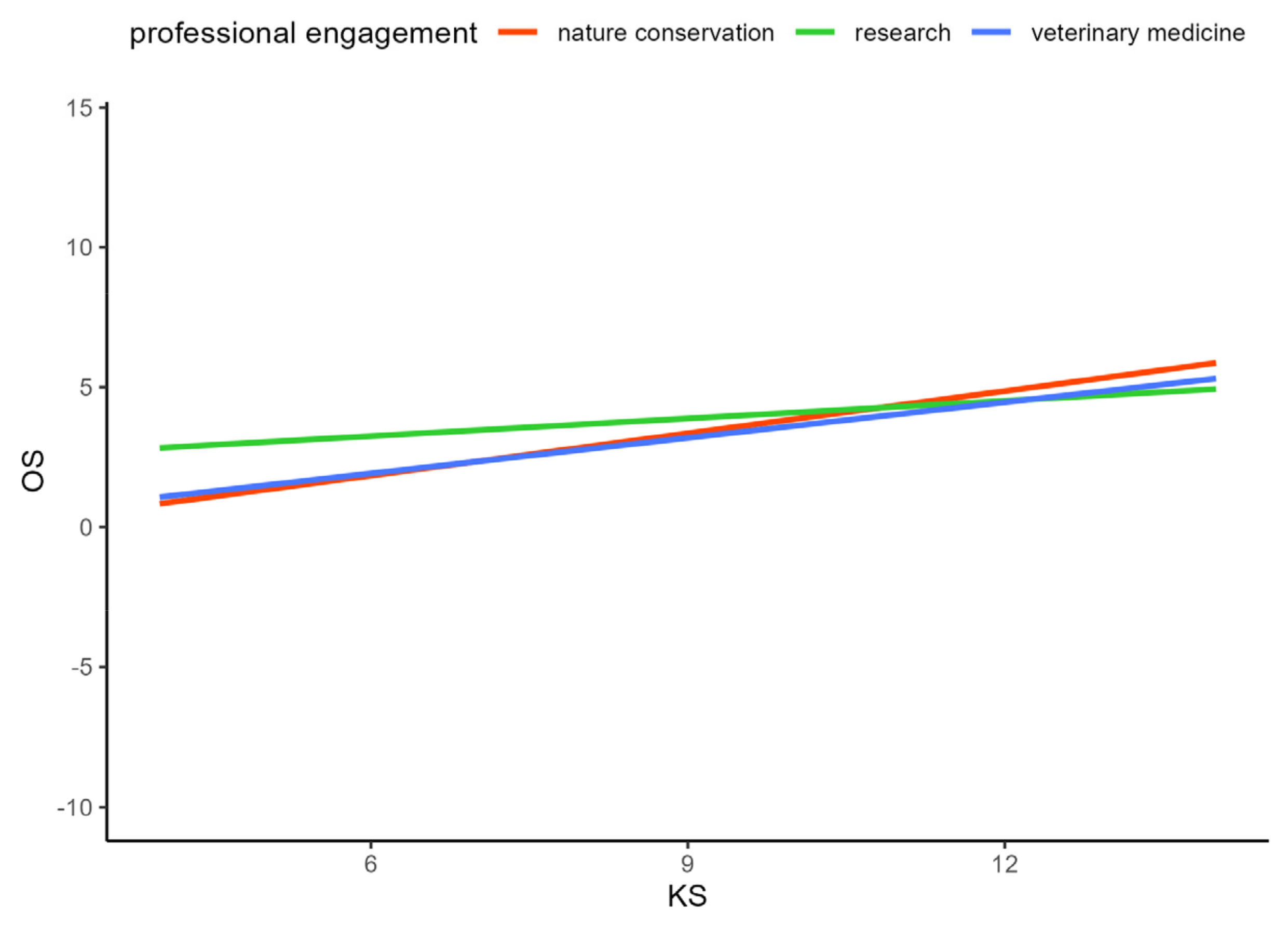
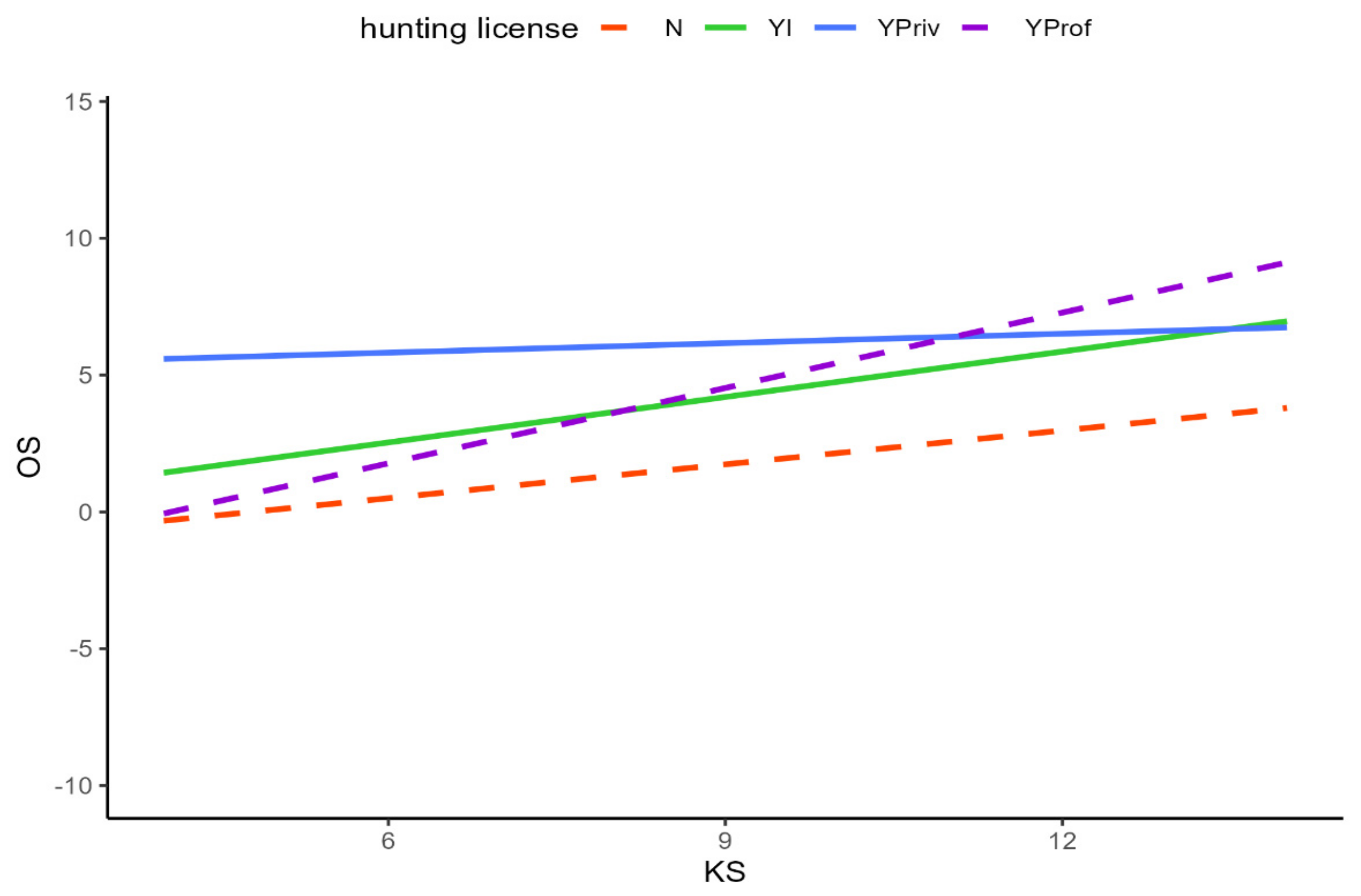

| Scores | Min. | Max. | Median | Raw Cronbach’s Alpha |
|---|---|---|---|---|
| Emotion (EmS) | −9 | 28 | 19 | 0.8 |
| Engagement (EnS) | 0 | 10 | 6 | 0.7 |
| Experience (ExS) | −2 | 17 | 5 | 0.8 |
| Knowledge (KS) | 4 | 14 | 10 | 0.5 |
| Opinion (OS) | −10 | 14 | 3 | 0.7 |
Disclaimer/Publisher’s Note: The statements, opinions and data contained in all publications are solely those of the individual author(s) and contributor(s) and not of MDPI and/or the editor(s). MDPI and/or the editor(s) disclaim responsibility for any injury to people or property resulting from any ideas, methods, instructions or products referred to in the content. |
© 2024 by the authors. Licensee MDPI, Basel, Switzerland. This article is an open access article distributed under the terms and conditions of the Creative Commons Attribution (CC BY) license (https://creativecommons.org/licenses/by/4.0/).
Share and Cite
Grundei, L.-L.; Schöttes, F.M.; Gethöffer, F.; Tost, D.; Kluge, L.; Siebert, U.; Pees, M. Human–Wildlife Interaction—A Social Survey. Animals 2024, 14, 808. https://doi.org/10.3390/ani14050808
Grundei L-L, Schöttes FM, Gethöffer F, Tost D, Kluge L, Siebert U, Pees M. Human–Wildlife Interaction—A Social Survey. Animals. 2024; 14(5):808. https://doi.org/10.3390/ani14050808
Chicago/Turabian StyleGrundei, Lara-Luisa, Franziska M. Schöttes, Friederike Gethöffer, Daniel Tost, Laurin Kluge, Ursula Siebert, and Michael Pees. 2024. "Human–Wildlife Interaction—A Social Survey" Animals 14, no. 5: 808. https://doi.org/10.3390/ani14050808
APA StyleGrundei, L.-L., Schöttes, F. M., Gethöffer, F., Tost, D., Kluge, L., Siebert, U., & Pees, M. (2024). Human–Wildlife Interaction—A Social Survey. Animals, 14(5), 808. https://doi.org/10.3390/ani14050808








